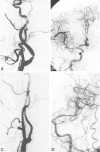Pattern of atherosclerotic carotid stenosis in Korean patients with stroke: different involvement of intracranial versus extracranial vessels
- PMID: 12591640
- PMCID: PMC7974145
Pattern of atherosclerotic carotid stenosis in Korean patients with stroke: different involvement of intracranial versus extracranial vessels
Abstract
Background and purpose: The clinical pattern of stroke and the angiographic distribution of cerebral atherosclerosis in the Japanese and Chinese are different from those in whites. Our purpose was to evaluate the location and distribution of severe atherosclerotic stenoses in Korean patients by using cerebral angiography.
Methods: We retrospectively reviewed the cerebral angiographic findings in 268 patients (219 male, 49 female; mean age, 56 years) with one or more severe atherosclerotic stenoses (> or =70%), as shown on angiograms. These patients were selected from 1436 patients who were examined between 1996 and 1997. The analysis focused on the intracranial or extracranial location of the stenosis, the anterior and posterior circulations, and the multiplicity of the lesions. Statistical analysis was performed by using the chi(2) test. The data were then compared with data reported in other races and ethnic groups.
Results: A total of 389 severe stenotic sites were detected in 268 patients. A single stenosis was found in 56 (21%), and multiple stenoses were found in 212 (79%). Lesions were located in the intracranial area in 52% and in the extracranial area in 48%. They were detected in anterior circulation in 59% and in posterior circulation in 41%. Thirty-seven (66%) of 56 single stenosis were located in the intracranial area, and 19 (34%) were in the extracranial area. Of 333 lesions, 167 (50%) were multiple stenoses in the extracranial area, and 166 lesions (50%) were located in the intracranial vessels. The prevalence of intracranial stenosis was significantly higher in the single-stenosis group than in the multiple stenosis group (P <.05).
Conclusion: Korean patients with severe atherosclerotic stenoses tend to have more intracranial stenoses. In particular, those with an isolated stenosis have more intracranial stenoses, compared with those with multiple stenoses.
Figures


References
-
- Korea National Statistical Office. Annual report on the cause of death statistics.2000
-
- Wolf PA, D’Agostino RB. Epidemiology of stroke. In: Barnett HJM, Mohr JP, Stein BM, Yatsu FM, eds. Stroke. 3rd ed. New York: Churchill Livingstone;1998. :3–28
-
- Frey J, Jahnke H, Bulfinch E. Difference in stroke between white, Hispanic, and Native American patients. Stroke 1998;29:29–33 - PubMed
-
- Sacco RL, Kargman DE, Gu Q, Zamanillo MC. Race-ethnicity and determinants of intracranial atherosclerotic cerebral infarction: The Northern Manhattan Stroke Study. Stroke 1995;26:14–20 - PubMed
-
- Feldmann E, Daneault N, Kwan E, et al. Chinese-white differences in the distribution of occlusive cerebrovascular disease. Neurology 1990;40:1541–1545 - PubMed
Publication types
MeSH terms
LinkOut - more resources
Full Text Sources
